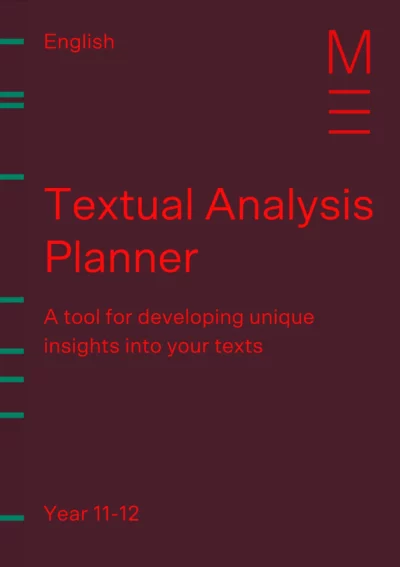Welcome to Matrix Education
To ensure we are showing you the most relevant content, please select your location below.
Select a year to see courses
Learn online or on-campus during the term or school holidays
Learn online or on-campus during the term or school holidays
Learn online or on-campus during the term or school holidays
Learn online or on-campus during the term or school holidays
Learn online or on-campus during the term or school holidays
Learn online or on-campus during the term or school holidays
Learn online or on-campus during the term or school holidays
Get HSC exam ready in just a week
Select a year to see available courses
Science guides to help you get ahead
Science guides to help you get ahead

The Year 12 Module B: Close Study of Literature is a challenging module in the HSC Standard English course. It requires you to gain an informed understanding of your text and the ideas it explores! In this article, we will break down the syllabus to know exactly you need to do to ace Standard English!
In this article, we’ll look at:
Tailor your analysis to the Module B rubric

Level up how you analyse texts and take notes with expert strategies and templates!

Fill out your details below to get this resource emailed to you.
"*" indicates required fields
HSC English Module B: Close Study of Literature requires you to closely read or watch your text. This shouldn’t be a surprise. You should re-read your prescribed text at least 2-3 times throughout your HSC year to build your confidence about the text.
You need to explore:
In short, for Module B you are judging the quality of the text and building your own personal opinion and connection.
You need to ask yourself, how does the text explore ideas in a unique way and how does it make you feel?
In your Module B responses, you will need to show a deep, sophisticated understanding of the complexities of your prescribed text – substantially more than what is required in other Modules. To perform well in your assessments and exams, you must know your text in detail and be able to discuss it with confidence and insight.
Engaging with a text can mean a few different things. Let’s take a look:

To get you ready for the rigours of Module B, we need to take a close look at the Module B rubric.
Being familiar with the Module rubrics is very important. It tells you what you need to do for Standard English.
Okay, let’s see what the Module B rubric states.
In this module, students develop an informed understanding, knowledge and appreciation of a substantial literary text. Through their development of considered personal responses to the text in its entirety, students explore and analyse the particular ideas and characteristics of the text and understand the ways in which these characteristics establish its distinctive qualities.
Students study one text chosen from the list of prescribed texts. They engage in the extensive exploration and interpretation of the text and the ways composers (authors, poets, playwrights, directors, designers and so on) portray people, ideas, settings and situations in texts. By analysing the interplay between the ideas, forms and language within the text, students appreciate how these elements may affect those responding to it. Students produce critical and creative responses to the text, basing their judgements on a detailed knowledge of the text and its language features.
Through reading, viewing or listening, students analyse, assess and comment on the text’s specific language features and form. They express increasingly complex ideas, clearly and cohesively, using appropriate register, structure and modality. They draft, appraise and refine their own texts, applying the conventions of syntax, spelling and grammar appropriately.
Through their analyses and assessment of the text and their own compositions, students further develop their personal and intellectual connections with, and enjoyment of the text, enabling them to express their informed personal interpretation of its significance and meaning.
Source: Module B Course Rubric from NESA website
Year 12 English Standard is about exploring how the human experience is represented in unique ways in texts. They often explore complex, confronting, challenging and even obscure ideas.
It is normal if you don’t understand your Module B text in the first reading or viewing. You might not even like the text. That is okay!
These texts are challenging because they explore challenging social and artistic values of their own context. Their ideas and even their style, structure and form may be different from what you’re used to reading or watching.
However, don’t be discouraged. These struggles are all part of the process and it will be very rewarding once you overcome it!
However, you must be prepared to invest a significant amount of time into the study of your Module B text. There are no quick solutions for English success. Once you’ve engaged with the text a couple of times, you will need to discuss your text with your friends, teachers, and others. You will need to research what others think of the text to understand your own perspective, too.
Doing this will help you develop and clarify your ideas. And, it will help you build a strong and sophisticated opinion about the text.
Your hard work will pay off when you discuss these insights in your Band 6 responses.
To do well in Module B, you must understand the Rubric. Sounds like a lot of work? Don’t worry. We’ve broken the Rubric down into 8 Rubric Statements and explained them in plain English.
Let’s take a look at what NESA wants you to do.
“In this module, students develop an informed understanding, knowledge and appreciation of a substantial literary text. “
This means that you need closely study a text or a series of text by one composer. You will find that Module B texts have important literary significance because of their reputation, ideas and construction.
So, you will need to demonstrate a deep knowledge of your text’s ideas, construction and characteristics that makes it significant. This means that you have to read the text multiple times:
To learn more, read our Textual Analysis Guide.

“Through their development of considered personal responses to the text in its entirety, students explore and analyse the particular ideas and characteristics of the text and understand the ways in which these characteristics establish its distinctive qualities.”
You are not merely studying single techniques and ideas within your text. You are analysing it as a whole.
This means that you have to use your critical thinking skills and see how different elements and characteristics of the text work together as a whole.
Attempt to identify distinctive features of the text… these are features that are unique to the text.
Here are some things you need to identify:
“Students study one text chosen from the list of prescribed texts. They engage in the extensive exploration and interpretation of the text and the ways composers (authors, poets, playwrights, directors, designers and so on) portray people, ideas, settings and situations in texts.“
This means that you need to identify the characteristics listed in the previous rubric point and figure out how the composer uses it in a specific way to represent different people, ideas, settings and situations in your prescribed text.
Everything you see in your text is a thoughtful decision by the composer.
Different uses of technique and form help build different atmospheres, and convey different ideas.
Even if you aren’t purposely identifying them, you will always feel their effects.
Every creative decision – technique or form – affects you in a different way. You might feel scared, or happy. You might hate a character or love them. So, as you break down the text, pay attention to your opinions and feelings about your text.
“By analysing the interplay between the ideas, forms and language within the text, students appreciate how these elements may affect those responding to it..”
As you continue to read the text multiple times, you will develop different interpretations of the text. This is because every time you re-read a text, discuss it with others, or research new information about the text, you realise something new about the form and language of the text and how it conveys ideas.
As such, Module B is all about identifying how your interpretation and understanding of the text changes over time.
So, it is crucial that you figure out your own opinions, judgement and interpretation of the text before you discuss it or research about it. You need to document your changing judgement and reflect on it, then you can discuss this in your responses.

“Students produce critical and creative responses to the text, basing their judgements on a detailed knowledge of the text and its language features. They draft, appraise and refine their own texts, applying the conventions of syntax, spelling and grammar appropriately.“
This rubric point refers to how you will respond in your assessments. The nature of the new Year 12 syllabus is that there is now less of a focus on traditional persuasive essays. Instead, you may have to respond in a variety of different ways.
You may be asked to produce a multimodal presentation. If you are studying Module B concurrently with Module C, you may be asked to write an imaginative recreation of the text. It is possible that you have an assessment task with multiple parts.
For example, you may be asked to write an imaginative recreation of the text and then produce a multimodal presentation that discusses your choices. In addition, you might be asked to write a reflection that evaluates your presentation against some of your peers’ presentations.
Each of these different tasks would require you to demonstrate different registers, structures, and modalities in your writing and speaking (if you want more information about this, read our post on the new Module C: The Craft of Writing).
“Through reading, viewing or listening, students analyse, assess and comment on the text’s specific language features and form. They express increasingly complex ideas, clearly and cohesively, using appropriate register, structure and modality”
This syllabus point refers to the process of critical analysis. If you need help with this, you should read Part 2 of our Beginner’s Guide to Acing HSC English: How to Analyse Your Texts.
In summary, you need to identify the techniques and explore how they convey ideas. Then, you need to make a judgement at its effectiveness in conveying these ideas.
Then, in your responses, you need to respond appropriately according to the tasks you’ve been set.
This means using the right level of language (register), organisation and presentation of ideas (structure), and level of certainty (modality). It’s important that you read your notifications to understand how you should approach the tasks.
For example, a formal essay is going to require a 5 paragraph structure in a formal register using high and medial modality language.
“They draft, appraise and refine their own texts, applying the conventions of syntax, spelling and grammar appropriately.”
In your responses, whether it be fiction or non-fiction writing, you will need to engage in the drafting process.
You must draft, write, re-write, edit, and ask for feedback on your creatives and essays. This process will ensure that you produce a refined piece of work that is free from errors.

“Through their analyses and assessment of the text and their own compositions, students further develop their personal and intellectual connections with, and enjoyment of the text, enabling them to express their informed personal interpretation of its significance and meaning “
This final point is the aim of Module B. NESA wants you to engage deeply with a text and find a connection with it.
That is, you need to develop a perspective on the text and find it’s significance on yourself and others. You then need to convey this concept to others in your responses
Prose fiction:
Poetry (p) or Drama (d):
Non-Fiction (nf), Film (f), or Media (m):
A systematic approach to Module B is the key to performing well.
Make it a priority to read the text – everything else depends upon this step.
Now you have got an understanding of the Module, you should expand your knowledge further.
Gain an in-depth textual understanding, explanations of critical analysis, and essay writing skills and test them with Matrix. Learn more about Matrix Standard English classes now.
© Matrix Education and www.matrix.edu.au, 2023. Unauthorised use and/or duplication of this material without express and written permission from this site’s author and/or owner is strictly prohibited. Excerpts and links may be used, provided that full and clear credit is given to Matrix Education and www.matrix.edu.au with appropriate and specific direction to the original content.